<Back to Index>
- Optician Carl Zeiss, 1816
- Poet Pierre de Ronsard, 1524
- 2nd Shogun of Kamakura Shogunate Minamoto no Yoriie, 1182
PAGE SPONSOR


Carl Zeiss (11 September 1816 – 3 December 1888) was a German maker of optical instruments commonly known for the company he founded, Carl Zeiss Jena (now: Carl Zeiss AG). Zeiss made contributions to lens manufacturing that have aided the modern production of lenses. Raised in Weimar, Germany, he became a notable lens maker in the 1840s when he created high quality lenses that were "wide open", or in other words, had a very large aperture range that allowed for very bright images. He did this in the city of Jena at a self opened workshop, where he started his lens making career. At first his lenses were only used in the production of microscopes, but when cameras were invented, his company began manufacturing high quality lenses for cameras.
Zeiss began his life in pre-imperial Germany where he went to a grammar school, and undertook apprenticeship under Dr. Friedrich Körner, mechanic and supplier to the court. He later attended lectures in mathematics, experimental physics, anthropology, mineralogy and optics at the University of Jena. After seven years he opened a small workshop with hardly any tools. He made many lenses but had little recognition until 1847 when he hired his second and third apprentice.
In 1847 Carl Zeiss started making microscopes full time. His first innovation was making simpler microscopes that only used one lens and were therefore only intended for dissecting work. He sold around 23 of them in his first year of production. He soon decided that he needed a new challenge so he began making compound microscopes. He first created the Stand I which went to market in 1857.
In 1861 he was awarded a gold medal at the Thuringian Industrial Exhibition for his designs. They were considered to be among the best scientific instruments in Germany. By this point he had about 20 people working under him with his business still growing. In 1866 the Zeiss workshop sold their 1,000th microscope.
In 1872 he joined up with physicist Ernst Abbe. Their combined efforts lead to the discovery of the Abbe sine condition. Theoretically, the Abbe sine condition could greatly improve how well lenses could be made. However, a form of glass strong enough to fully test the theory did not exist at the time. Abbe then met Otto Schott, a 30 year old glass chemist who had just received his doctorate. They collaborated and soon produced a new type of glass in 1886 that could fully use the Abbe sine condition. This new type of glass made possible a new class of microscope objective: the apochromatic (often abbreviated 'apo'). Zeiss used water immersion to form a compensating eyepiece which produced images with little or no color distortion.
His son had entered the business with him but retired soon after Carl Zeiss's death of natural causes on 3 December 1888. The business was incorporated as the Carl - Zeiss - Stiftung in 1889. It gained an international reputation for the manufacture of optical instruments of all kinds, and remains in business to this day.